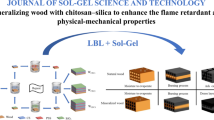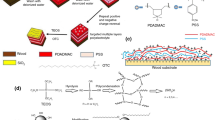Abstract
The present study contributes to the controversial discussion in the literature whether Si–O–C bonds in wood–silica–gel composites exist. 13C NMR is a suitable method to proof such bonds. Because of the low concentration of 13C isotopes in natural wood, 13C cellulose was used as 13C-enriched substitute. A tailored sol for the impregnation of that cellulose was chosen by liquid 29Si NMR pre-investigations of various sols whose reactivity and stability were time-dependently analysed. It is based on a sub-stoichiometric hydrolysis of tetraethoxysilane (TEOS) with 1 mol water per mol TEOS. Thermal analyses were performed to show a comparability of the thermal behaviour of wood–silica–gel and cellulose–silica–gel composites. There are two strong hints of the existence of stable Si–O–C bonds: (1) by thermal analysis, a shift in the fire behaviour of 100 K can be observed with a change in pyrolysis behaviour of the composite and (2) the proof by REDOR NMR that a dipolar coupling between 29Si and 13C nuclei exists.







Similar content being viewed by others
References
Bennett AE, Rienstra CM, Auger M, Lakshmi KV, Griffin RG (1995) Heteronuclear decoupling in rotating solids. J Chem Phys 103:6951–6958
Brinker CJ, Scherer GW (1990) Sol–gel science: the physics and chemistry of sol–gel processing. Academic Press, ISBN 0-12-134970-5
Brinker CJ, Sehgal R, Raman N, Schunk PR, Headley TJ (1994) Polymer approach to supported silica membranes. J Sol Gel Sci Technol 2:469–476
Cook RL, Langford CH, Yamdagni R, Preston CM (1996) A modified cross-polarization magic-angle spinning C-13 NMR procedure for the study of humic materials. Anal Chem 68:3979–3986
Donath S, Militz H, Mai C (2004) Wood modification with alkoxysilanes. Wood Sci Technol 38:555–566
Drzal LT, Askeland P, Lu J (2008) Surface modification of microfibrillated cellulose for epoxy composite applications. Polymer 49:1285–1295
Engelhardt G, Michel D (1987) High-resolution solid-state NMR of silicates and zeolites. John Wiley and Sons, Chichester
Gullion T, Schaefer J (1989) Development of REDOR rotational-echo double-resonance NMR. J Magn Reson 81:196–200
Hill CAS, Papadopoulos AT (2001) A review of methods used to determine the size of the cell wall micro voids of wood. J Inst Wood Sci 15:337–345
Mahltig B, Swaboda C, Roessler A, Böttcher H (2008) Functionalising wood by nanosol application. J Mater Chem 18:3180–3192
Mai C, Militz H (2004) Modification of wood with silicon compounds. Inorganic silicon compounds and sol–gel systems: a review. Wood Sci Technol 37:339–348
Mantanis G, Papadopoulos A (2010) The sorption of water vapour of wood treated with a nanotechnology compound. Wood Sci Technol 44:515–522
Miyafuji H, Saka S (1996) Wood-inorganic composites prepared by sol–gel processing. 5. Fire-resisting properties of the SiO2-P2O5-B2O3 wood-inorganic composites. Mokuzai Gakkaishi 42:74–80
Miyafuji H, Saka S (1999) Topochemistry of SiO2 wood-inorganic composites for enhancing water-repellency. Mater Sci Res Int 5(4):270–275
Miyafuji H, Saka S (2001) Na2O–SiO2 wood-inorganic composites prepared by sol–gel process and their fire-resistant properties. J Wood Sci 47:483–489
Miyafuji H, Saka S, Yamamoto A (1998) SiO2-P2O5-B2O3 wood inorganic composites prepared by metal oxide oligomers and their fire-resisting properties. Holzforschung 52:410–416
Neder RB, Burghammer M, Grasl T, Schulz H, Bram A, Fiedler S (1999) Refinement of the kaolinite structure from single-crystal synchrotron data. Clays Clay Miner 47:487–494
Ogiso K, Saka S (1994) Wood-inorganic composites prepared by sol–gel process IV: effects of chemical bonds between wood and inorganic substances on property enhancement. Mokuzai Gakkaishi 40:1100–1106
Reinsch S, Böcker W, Bücker M, Seeger S, Unger B (2002) Development of wood-inorganic composites with enhanced properties and environmental stability. Proceedings of 4th international wood and fibre composites symposium, Kassel: 50-1–50-6
Rosenthal M, Bues C-T (2010) Longitudinal penetration of silicon dioxide nanosols in wood of pinus sylvestris. Eur J Wood Prod 68:363–366
Rudolph M (1987) Kinetik der Hydrolyse und Kondensation von Alkoxysilanen. Ph.D. thesis 1987, University of Ulm, Germany
Saka S, Miyafuji H (2005) Application of sol–gel processing to wood-inorganic composites. in handbook of sol–gel science and technology: vol 3, chap 27, Kluwer Academic Publishers, 577–595
Saka S, Sasaki M, Tanahashi M (1992) Wood-inorganic composites prepared by sol–gel processing I: wood-inorganic composites with porous structure. Mokuzai Gakkaishi 38:1043–1049
Saka S, Miyafuji H, Tanno F (2001) Wood-inorganic composites prepared by the sol–gel process. J Sol Gel Sci Technol 20:213–217
Sèbe G, Brook MA (2001) Hydrophobization of wood surfaces: covalent crafting of silicone polymers. Wood Sci Technol 35:269–282
Singh T, Singh AP (2012) A review on natural products as wood protectant. Wood Sci Technol 46:851–870
Trepte J (1999) Silicium-nanosole für den holzschutz. nano III/99; nano-technology center of competence, “ultrathin functional films” in Fraunhofer IWS, Dresden, Germany
Unger B, Jancke H, Hähnert M, Stade H (1994) The early stages of the sol–gel processing of TEOS. J Sol Gel Sci Technol 2:51–56
Unger B, Rurack K, Müller R, Jancke H, Resch-Genger UJ (2005) Microscopic vs. macroscopic evolution of SiO2 sols and gels employing a tailor-made fluorescent reporter dye. Mater Chem 15:3069–3083 ISSN 0959–9428
Unger B, Bücker M, Reinsch S, Hübert T (2013) Chemical aspects of wood modification by sol–gel derived silica. Wood Sci Technol 47:83–104
Author information
Authors and Affiliations
Corresponding author
Rights and permissions
About this article
Cite this article
Bücker, M., Jäger, C., Pfeifer, D. et al. Evidence of Si–O–C bonds in cellulosic materials modified by sol–gel-derived silica. Wood Sci Technol 48, 1033–1047 (2014). https://doi.org/10.1007/s00226-014-0657-9
Received:
Published:
Issue Date:
DOI: https://doi.org/10.1007/s00226-014-0657-9




